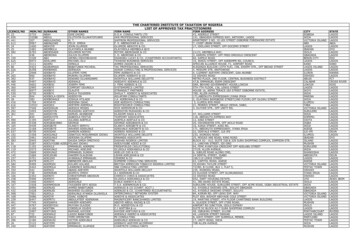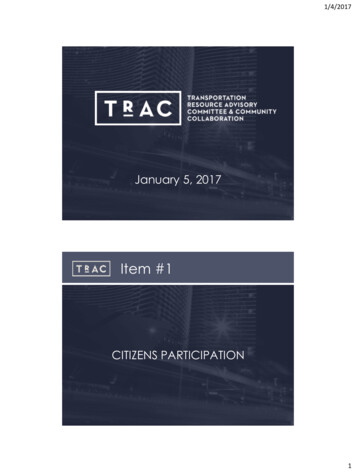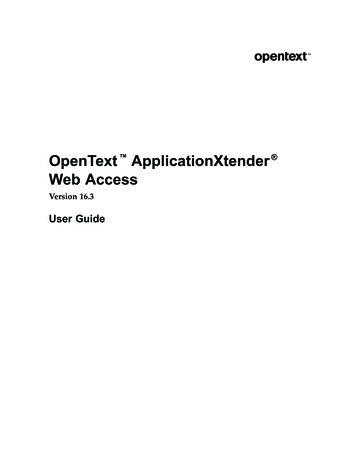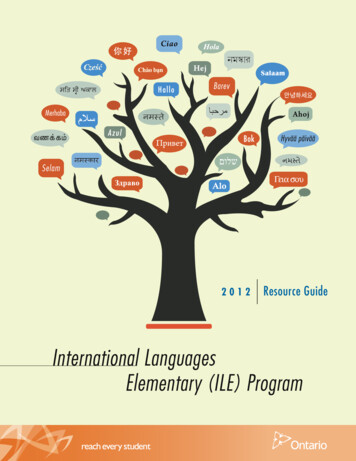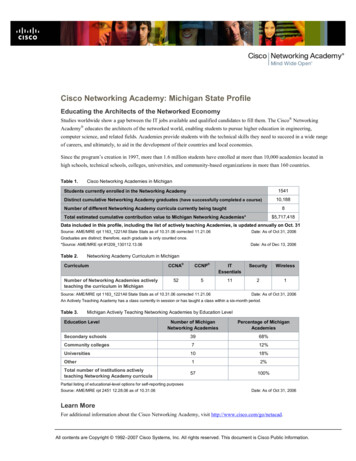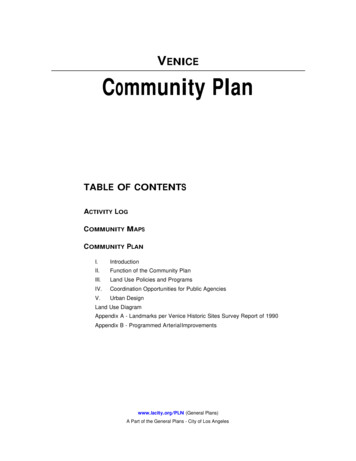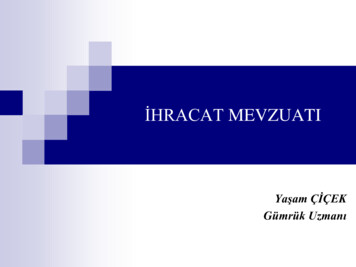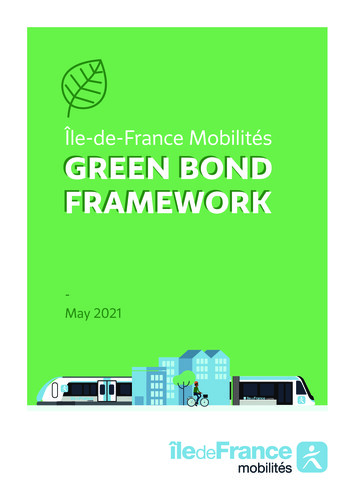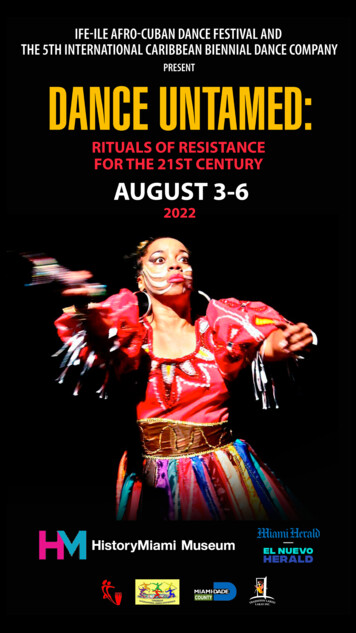
Transcription
As we find ourselves in the midst of theaggressive clouds of war, disease of body and soul,senseless conflicts and constant instability,we invite you to come together in the circle ofour conference, which delves into the alienated ritualsof dance and sidelined practices, reconnecting with ourtrue history of community through various traditionsto repair the fragmentation of families, people,societies, countries VenuesHistoryMiami Museum101 W Flagler St, Miami, FL 33130(Academic panels and opening performance by IFE-ILE)Miami Dade College Koubek Memorial Center2705 SW 3rd St, Miami, FL 33135(Workshops and performance)
SCHEDULE aug 3-4@ HistoryMiamiMuseum@ HistoryMiamiMuseumWednesdayAugust 3ThursdayAugust anelsAcademicPanels4:00pOpening Performanceby IFE-ILE
SCHEDULE aug 5-6@ Koubek Center@ Koubek CenterFridayAugust 5SaturdayAugust 68:30amRegistrationRegistration9:00a – 9:50aCuban 10:50aOrishas(Eleggua)GonzalezOrishas(Babalu dsCaribfunkCarey4:00p-4:50pBailes Populares(Mambo, Son, Chachacha)Lizaso5:00p-5:50pCasinoGarcia8:00pGala Performance10:00pClosing PartyTheater Lobby
Guest instructorsAndrea E. WoodsValdés– Dancer/Choreographer/Musician/Video Artist/Educator – is the Chair of the Duke University DanceProgram and artistic director of Souloworks/AndreaE. Woods & Dancers. She found the wimmim@workshowcase and the Calabasa Calabasa summerintensive to develop Black audiences and performingand teaching opportunities for wimmin of color. She isa former dancer/rehearsal director with Bill T. Jones/Arnie Dance Co. She holds an MFA in Dance from TheOhio State University and a MAH in Caribbean CulturalStudies from SUNY Buffalo and is completing a Ph.D.(ABD) in Dance at Texas Woman’s University.Woods Valdés has received grants from The JeromeFoundation, (NEFA) The National Dance Project,National Performance Network, Arts International, andthe North Carolina Arts Council. Woods Valdés createsdances as contemporary African American folklore.Her creative process is inspired by folk traditions suchas blues, jazz, folk music, African American literature,family folklore and movement reflective of the AfricanDiaspora social and cultural experience. She hascreated collaborative works with musicians RandyWeston, David Pleasant, Tiyé Giraud, MadeleineYayodele Nelson, Philip Hamilton, Shana Tucker, andAtiba Rorie and performance poet, hattie gossett.www.SOULOWORKS.com
A’Keitha Careyis a Bahamian artist, educator, scholar, mother,and activist. She developed the dance techniqueCaribFunk, a fusion of Afro-Caribbean, ballet, modern,and fitness principles and rooted in Africanist andEuro-American aesthetics and expressions. Shereceived her B.A. in Dance from Florida InternationalUniversity, an M.F.A. in Dance from Florida StateUniversity, and an M.A. in African and AfricanDiaspora Studies from Florida International University.She also holds a Certificate in Women’s Studies fromTexas Woman’s University and is currently in PhDprogram in Global Cultural Studies at FloridaInternational University. She researches Caribbeanspaces, locating movements that are indigenous,contemporary, and fusion based and investigates howCaribbean cultural performance (Bahamian Junkanoo,Trinidadian Carnival, and Jamaican Dancehall) can beviewed as praxis. Her dissertation focus is:“Deconstructing the Erotic: Vulgarity, Slacknessand Black Female Performance in JamaicanDancehall.” She is also a member ofOlujimi Dance Theatre in Miami, Florida.
Weiselande ‘Yanui’Césaris a multidisciplinary artist residing in Miami. Dr. César isan educator of MDCPS. She is also the FoundingExecutive Director of Tradisyon Lakou Lakay Inc. Herliterary work includes three self-published books andarticles. Recently published in the National DanceEducation Organization was her blog, “DemystifyingHaitian Folkloric Dance through Pedagogy andPerformance Art”. Her much inspiring and spirit upliftingworkshop, Haitian Folkloric Dance LAB was presentedat the National Dance Education OrganizationConference in October 2019 at the Hyatt Regency,Miami. Her work ranges from collaborative toindependent projects, lending her in a 2018 productionwith Berlin based choreographer/experimental artist,Isabel Lewis, during Faena’s commissioned Art BaselFestival. Yanui’s choreographed piece, directing TLLDance Ensemble, led the group to a cast in “Colors”Jason Derulo 2018 music video. Yanui was also afeatured artist in VoyageMIA magazine in 2019.Through the nonprofit, the organization ConcertSeries made its debut at Julius Littman Performing ArtsTheater, a work commissioned by the City of NorthMiami Beach. In May 2021, Dr. César’s future workalso includes a proposed Haitian Folkloric DancePerformance and Pedagogy class at the NationalDance Education Organization’s Online Professionaland Development Institute (ODPI). This work will bethe first presented on the platform and at thisprofessional caliber
IFE-ILE InstructorsNeri Torres– dancer, is the founder and director of IFE-ILE andthe Annual Afro-Cuban Dance Festival (now mergedwith the International Biennial Caribbean DanceConference Torres founded in 2014 in Barbadoswhile working at UWI). Born in Havana, Cuba, Neristudied at the Escuela Nacional de Instructores deArte and Instituto Superior de Artes prior to defect tothe U.S. in 1991. She holds and MFA from Universityof Colorado at Boulder where she minored in film.She turned her passion for dance and culturaladvocacy into a successful career spanning morethan twenty years. Trained in jazz, ballet, modern,and Afro-Cuban dance, Torres has choreographed,written, directed and performed numerous shows(from musicals, movies, commercials to videos).Among her achievements are being the choreographerand principal dancer for Gloria Estefan. Neri is aleader in Miami’s arts and culture community, whosenumerous awards include a Fellowship of Artistic Meritand a Folk Heritage Award from the State of Floridafor her long-standing contributions to Afro-Cubanculture. Currently, Neri is a Visiting Professor at theUniversity of Texas at El Paso and a Policy Boardmember of the National Dance Education Organization(NDEO). She is the main editor of the bookPerspectives on Dance Fusion and DanceSustainability in the Caribbean Rituals ofModern Society.
Yosvani Gonzalezgraduated from both Escuela Nacional de Artesand Instituto Superior de Artes in Havana, Cuba inAfro-Cuban Dance and Music. Founder of Oche, thefirst Afro-Cuban dance Company in Villa Clara, Cubain 1996, Yosvani was also member of the renownedConjunto Folklorico Nacional de Cuba where heworked for over a year. In addition, he participatedin several festivals and dance competitions bothnational and internationally. After fulfilling a contractwith the University of Monterrey Campus, Guadalajara,he relocated to Miami in 2015, the year he joinedIFE-ILE Dance Company.Juinier QuinteroGraduated in 2009 from the Instituto Superior deArtes in Havana, Cuba in Afro-Cuban Folklore. Hedanced for the renowned Conjunto FolcloricoNacional de Cuba. In addition he choreographed forseveral Cuban nightclubs (Havana Riviera Hotel andCapri Hotel in Havana among other). Juinier wasalso a dance instructor for Baile en Cuba andVaradero Baila. He joined IFE-ILE Afro-CubanDance Company in 2013.
Jorge Lizasostudied at the National School of Art Instructorswith an internship at the National School of Arts.Graduated from the Instituto Superior de Artes,Jorge developed his career as a dancer, teacherand choreographer, participating in festivals andevents in Cuba, Mexico, USA, Spain, Italy, France,Germany and Venezuela.Rainier GarciaGraduated from the National School of PerformingArts in Havana, Cuba, in the specialty of MusicalShows in 2009. Rainier is a versatile dancer.During his career he has performed at therenowned cabaret Tropicana, Santiago Alfonso’sDance Company and Ballet Rakatan. He hasbeen a member of IFE-ILE since 2014.
workshopsAfro-ModernDance technique combining Afro-Cuban based dance movements withmodern technique, influenced by Graham, Limon, Humphrey and Limon.AraráFrom the Fon people and the Arara kingdom of the Dahomean region,now known as Benin, Arará rhythms, songs and dances were introducedinto Cuba, where many of those rituals and ceremonies are still practiced.One of the main characteristics of this style is the percussive use of theupper spine.Congoor Palo traditions come from the Bantú people of Central Africa (particularlyfrom Congo). The Bantú represent the majority of African slaves cominginto Cuba during the 17th and early 18th century; later the Yoruba (fromNigeria) became the primary group brought to Cuba as slaves. Drums andhand rattles are used in this music, which is based upon communicationwith ancestral spirits, the dead, as opposed to the Orishas. The songs andchants, often in a hybrid combination of Spanish and Bantú words, play acentral role in the rituals of Palo. Music of this tradition has had a stronginfluence on popular music forms like Rumba, Son and Mambo. It hasthree distinctive styles: Yuka, Makuta and Palo, known as Congo cycle.Cuban SalsaRueda de Casino Casino/Rueda is an exhilarating form of Salsa dancing,which some people call Cuban Square Dancing because it involvescouples exchanging partners. The term Casino comes from the fact thatit started in the 1950s in a Havana social club called El Casino Deportivo,and was brought to Miami by the first wave of Cuban exiles. Over the
years, Casino has grown not just in size but also in complexity and style,influenced by new contexts. There are dozens of turns, and each has aname and most have hand signals and are called by the male leader ofthe rueda. This form of dancing salsa is popular because of how itconnects dancers with each other both physically and mentally.OrishasSacred African dances originated in the Yoruba traditions of Nigeria-- theroot of many Cuban popular styles. Dances for Orishas such as Yemaya,Eleggua, Ochun, Oya, etc., which represent omnipresent and anthropomorphous forces of natureRumba ColumbiaIn this fast and energetic style of rumba, with a 6/8 feel, solo male dancersprovokes the drummers to play complex rhythms that they imitate throughtheir creative fast pace and acrobatic movements. Men may also competewith other men to display their agility, strength, confidence and even senseof humor. Columbia incorporates many movements derived from Abakua,Yoruba and Congo dances as well as Spanish flamenco. More recentlydancers have incorporated dancing and hip hop moves. Unlike its all malespecific origin, some women are also beginning to dance Columbia, too.Son(Traditional Cuban “on 2” dance)Son is derived from Cuba’s African and Spanish roots, and is thepredecessor of what is now called salsa. Originally rural music thatdeveloped as an accompaniment to dancing, it became a popular inCuba’s urban areas in the 20th century. Eventually, it was adapted tomodern instrumentation and larger bands. Traditional Son instrumentationcould include the tres (a type of guitar with three sets of closely spaced strings),standard guitars and various hand drums and other percussion
instruments. Many sons also include parts for trumpets and other brassinstruments, due to the influence of American jazz.CaribFunk Techniqueis a fusion of traditional and social Afro-Caribbean, classical ballet, modern,and fitness elements, identifying the body as a site of knowledge whileilluminating the transformative performances of the pelvis. It identifiesCaribbean cultural performance (Bahamian Junkanoo, JamaicanDancehall, and Trinidadian Carnival) as praxis through “the erotic” –thespiritual, sensual, and political. Participants perform social narrativesof the physical, cultural, and material Caribbean diaspora whilechallenging the politics of space/place, offering a space/place to performhip-mancipation, a Black performance aesthetic Carey coined to describethe sovereignty expressed through the gyrations of the hip displayedat Caribbean performance sites.Afro-ContemporaryDance exploring rhythm, and the impulses of movement developed throughthe ribs, pelvis, and spine. Wood Valdés’ influences include postmoderndance, Afro-Cuban folklore and movement reflective of the African diasporasocial and cultural dynamic. Live percussion accompaniment.Haitian dancePeople with diverse backgrounds can better make connections andfound commonality in the arts, culture, more so demystify the FolkloricDance. Haitian Folk Dance LAB is intended to use movements as acommunication tool steering one to divinely inspired and upliftingmovements. These movements along with live drumming serve to healand propel one to experience greater creative flow. The LAB also aimsto educate and leverage Haitian performing arts. Participants may alsohave the opportunity to make connection to Katherine Dunham techniquesas a derivation of Yanvalou of the Haitian Folkloric dances.
PerformancesWednesdayAugust 3rd at 4:00 pmIFE-ILE performs a conga at HistoryMiami Museum Plaza(following the academic panels)101 W Flagler St, Miami, FL 33130SaturdayAugust 6th at 8:00 pmMiami Dade College Koubek Memorial Center2705 SW 3rd St, Miami, FL 33135Registration and tickets:www.ife-ile.org(Schedule subject to change)
University, an M.F.A. in Dance from Florida State University, and an M.A. in African and African Diaspora Studies from Florida International University. She also holds a Certificate in Women's Studies from Texas Woman's University and is currently in PhD program in Global Cultural Studies at Florida International University. She researches .
